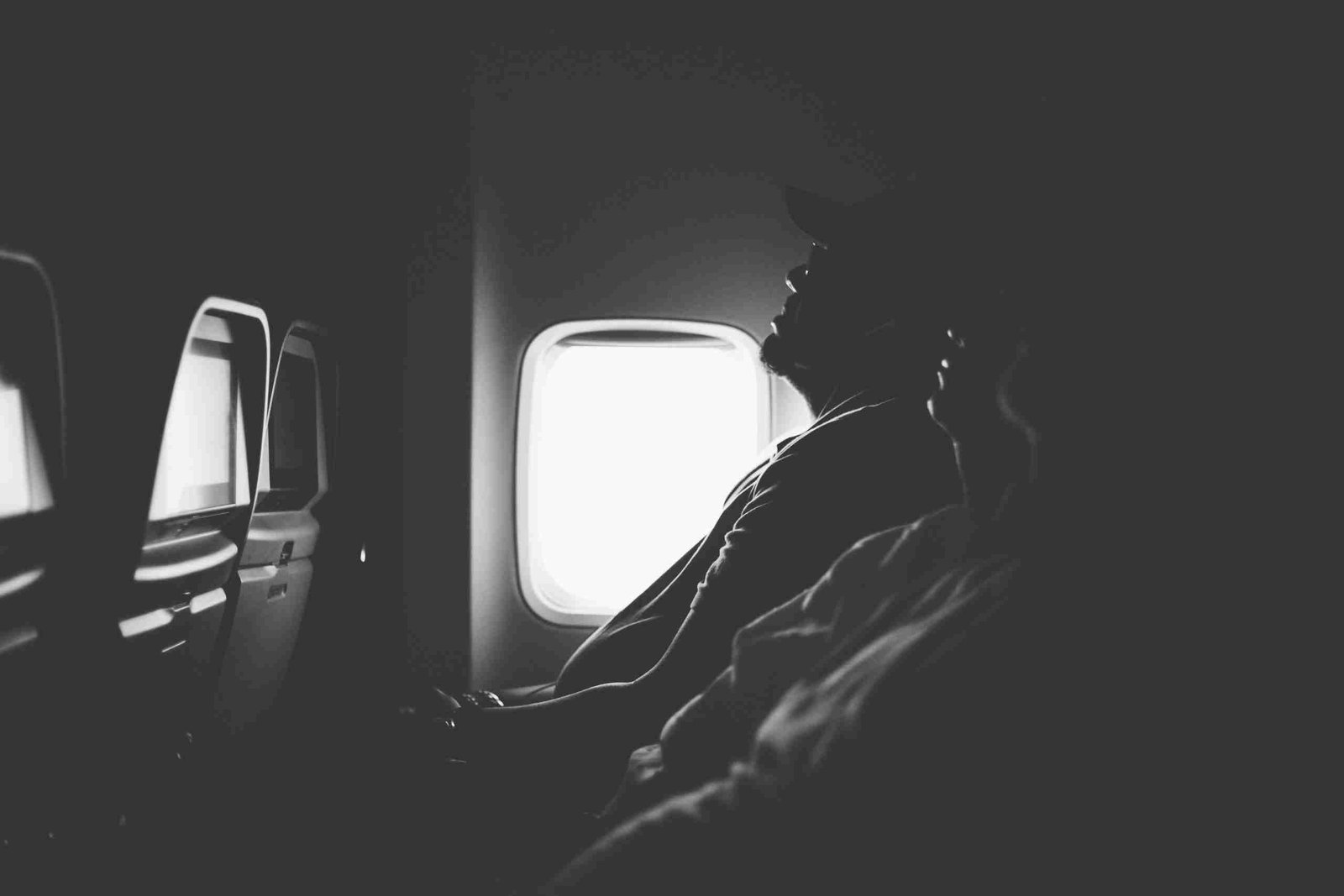
1. Choose the right seat
When aiming for quality sleep on a long haul flight, picking the right seat is crucial. Opting for a window seat on a plane provides a solid headrest, offering better chances of resting your head comfortably. On the other hand, an aisle seat allows easier leg movement and quick access to the aisle without disturbing fellow passengers.
Moreover, avoiding seats near the galley or lavatory on the plane can significantly reduce noise and disturbance during the flight. This choice enhances your chances of uninterrupted sleep on the plane by minimizing disruptions from other passengers moving around or using facilities close to your chosen spot.
2. Wear bed socks
To achieve better sleep during a flight, wearing bed socks on a plane can make a significant difference. Keeping your feet warm not only promotes sleep but also prevents discomfort from the cold plane cabin floors, allowing you to slip into slumber more easily.
3. Use a light-blocking eye mask
Using a light-blocking eye mask can significantly improve your ability to sleep on a plane. By blocking out ambient light, the eye mask creates an environment conducive to better sleep quality on a plane. This is especially crucial as the cabin lighting during plane flight can be disruptive and hinder sleep.
Moreover, wearing a light-blocking eye mask enhances melatonin production. Melatonin is a hormone that regulates sleep-wake cycles, and its production is stimulated by darkness. By using an eye mask to create darkness despite the surrounding environment, you can naturally regulate your sleep patterns and improve the overall quality of rest obtained during the flight.
Studies have shown that exposure to artificial light at night can suppress melatonin secretion, leading to difficulties in falling asleep and disrupted sleep patterns. Therefore, using an eye mask becomes essential for minimizing disruptions from cabin lighting and promoting natural melatonin release for improved sleeping conditions.
In addition to these benefits, some travelers may find it easier to fall asleep when they use an eye mask due to psychological comfort or association with bedtime routines at home.
4. Listen to pink noise
Listening to pink noise through headphones can significantly enhance the quality of sleep during a flight. Pink noise, similar to white noise but with a softer frequency, effectively masks background sounds such as engine hum and chatter, promoting deeper relaxation and better sleep.
By drowning out disruptive noises, pink noise creates a tranquil environment conducive to restful sleep. Studies have shown that exposure to pink noise leads to longer periods of deep sleep and improved overall sleep quality on planes.
For example, in one study published in the journal Sleep Medicine, researchers found that participants who listened to pink noise experienced an increase in slow wave sleep – the deepest phase of non-REM sleep associated with enhanced cognitive function and mood regulation.
Furthermore, using headphones for sleep listening ensures that the soothing sound frequencies are not disturbed by ambient disturbances. This allows travelers to create their personal oasis of calm amidst the often chaotic airplane environment.
5. Uncross legs and use footrests
To prevent numbness and discomfort in the legs and ensure proper sleep, it’s crucial to avoid crossing your legs for extended periods during a flight. Crossing legs can impede blood flow, leading to discomfort and potential health risks. Using footrests or adjustable leg rests can help maintain proper blood circulation and support the legs at an optimal angle, reducing strain on the lower body.
Maintaining an uncrossed leg position, utilizing footrests, and getting enough sleep can significantly reduce the risk of developing deep vein thrombosis (DVT). DVT is a condition where blood clots form in deep veins, often occurring in the lower limbs due to prolonged immobility and sleep. By keeping your legs uncrossed and using footrests when available, you actively promote healthy circulation throughout your lower extremities.
For example, some airlines provide adjustable footrests or even offer passengers with inflatable leg hammocks that attach to their seat tray tables. Taking advantage of these amenities, including sleep, not only enhances comfort but also contributes to overall well-being during long flights.
6. Lean backward with proper support
To ensure a comfortable sleep on the plane, it’s essential to provide adequate support for your lower back. Utilize a cushion or roll-up blanket to maintain spinal alignment and minimize strain on your back muscles.
By supporting your lower back during sleep, you can alleviate pressure points and reduce discomfort. This simple adjustment can significantly enhance your overall sleeping experience, allowing you to arrive at your destination feeling more refreshed.
Properly aligning your spine while leaning backward also promotes better blood circulation, preventing stiffness and soreness upon waking up. This small investment in comfort can make a substantial difference in how well-rested you feel after traveling.
Maintaining good posture by using proper support for your lower back and getting enough sleep contributes to reducing the risk of developing musculoskeletal issues associated with prolonged sitting. This practice is especially crucial for frequent travelers who spend extended periods in transit to sleep.
7. Embrace a neck pillow
Using a neck pillow can significantly enhance the quality of your sleep.
Supporting your neck is crucial for preventing stiffness and discomfort during sleep, especially in an upright position. By cradling the head and neck, these pillows promote better sleep alignment and reduce strain.
Embracing a neck pillow not only supports the natural curvature of the spine but also improves overall comfort while resting on the plane. This allows you to relax more deeply and fall asleep faster.
Furthermore, using a neck pillow can help reduce the risk of waking up with neck pain or soreness, enabling you to arrive at your destination feeling refreshed rather than fatigued.
8. Avoid alcohol and caffeine
Prevent dehydration by avoiding caffeine, which can disrupt sleep patterns. Caffeine is a diuretic that causes increased urination, potentially leading to dehydration during flights. This disruption can affect the body’s ability to regulate its internal clock, making it harder to fall asleep.
Minimize potential disturbances to your sleep and circadian rhythm by steering clear of alcohol. While alcohol may initially make you feel drowsy, it can negatively impact the quality of your sleep. It reduces rapid eye movement (REM) sleep and increases wakefulness during the second half of the night, ultimately disrupting your natural sleep cycle.
Reducing the likelihood of frequent bathroom trips is another benefit of avoiding these substances. Alcohol acts as a bladder irritant, increasing urine production and potentially causing more disruptions during rest. By eliminating both alcohol and caffeine from your in-flight consumption, you decrease interruptions that could prevent you from achieving deep and restful sleep.
9. Stay humid and hydrated
Combat the dry cabin air by prioritizing hydration throughout your flight. Dehydration can exacerbate jet lag and affect your overall well-being, so it’s crucial to consume water regularly during the journey. Using a nasal spray or saline solution can help moisturize your nasal passages, preventing discomfort caused by the low humidity levels in the plane.
By staying well-hydrated, you can alleviate some of the negative effects of air travel on your health. The low humidity in airplane cabins often leads to dehydration due to increased respiratory and skin moisture loss, which could impact your comfort and even contribute to conditions like headaches or fatigue.
To maintain optimal hydration levels during flights, consider bringing an empty reusable water bottle through security and filling it up before boarding. This way, you’ll have access to water whenever needed without relying solely on in-flight service.
In addition to drinking water regularly, incorporating hydrating foods such as fruits and vegetables into your pre-flight meal or snack pack can also contribute to keeping you adequately hydrated throughout the journey.
Remember that combating dry cabin air doesn’t just stop at drinking water; taking measures like using a nasal spray or saline solution is equally important for maintaining comfort and minimizing potential health issues associated with prolonged exposure to low humidity levels.
10. Practice mindfulness meditation
Deep breathing techniques are a proven way to relax and unwind during flights. By taking slow, deep breaths, you can calm your mind and body, reducing stress and promoting relaxation.
Focusing on the present moment is crucial for alleviating anxiety and restlessness while flying. Mindfulness meditation encourages individuals to concentrate on their immediate surroundings, effectively diverting attention away from any discomfort or unease.
Incorporating mindfulness exercises into your pre-flight routine can significantly promote mental calmness. Engaging in activities such as guided meditation or visualization techniques helps create a peaceful state of mind conducive to sleep.
Frequently Asked Questions
Is it really possible to sleep comfortably on a plane?
Absolutely! With the right strategies and gear, you can improve your chances of catching some Zs in the air. From choosing the best seat to wearing comfy bed socks, there are plenty of tips to help you nod off peacefully.
Why is it important to wear bed socks when sleeping on a plane?
Bed socks keep your feet warm and cozy, which helps signal to your body that it’s time for rest. Plus, they provide an extra layer of comfort if you decide to kick off your shoes during the flight.
How does using a light-blocking eye mask contribute to better sleep on a plane?
Blocking out light with an eye mask signals to your brain that it’s time for slumber. It creates a dark environment conducive to sleep, regardless of whether your neighbor has their reading light on.
Can listening to pink noise really help me relax and fall asleep on a plane?
Yes! Pink noise has been shown to have calming effects by masking other sounds and promoting relaxation. It’s like having a soothing background melody that lulls you into dreamland.
What are some effective ways I can stay hydrated during long flights without needing constant bathroom breaks?
Opt for hydrating foods like fruits and vegetables while also sipping water regularly. This helps maintain hydration without overloading your bladder. Consider using nasal sprays or saline solutions if the air inside the cabin feels dry.



